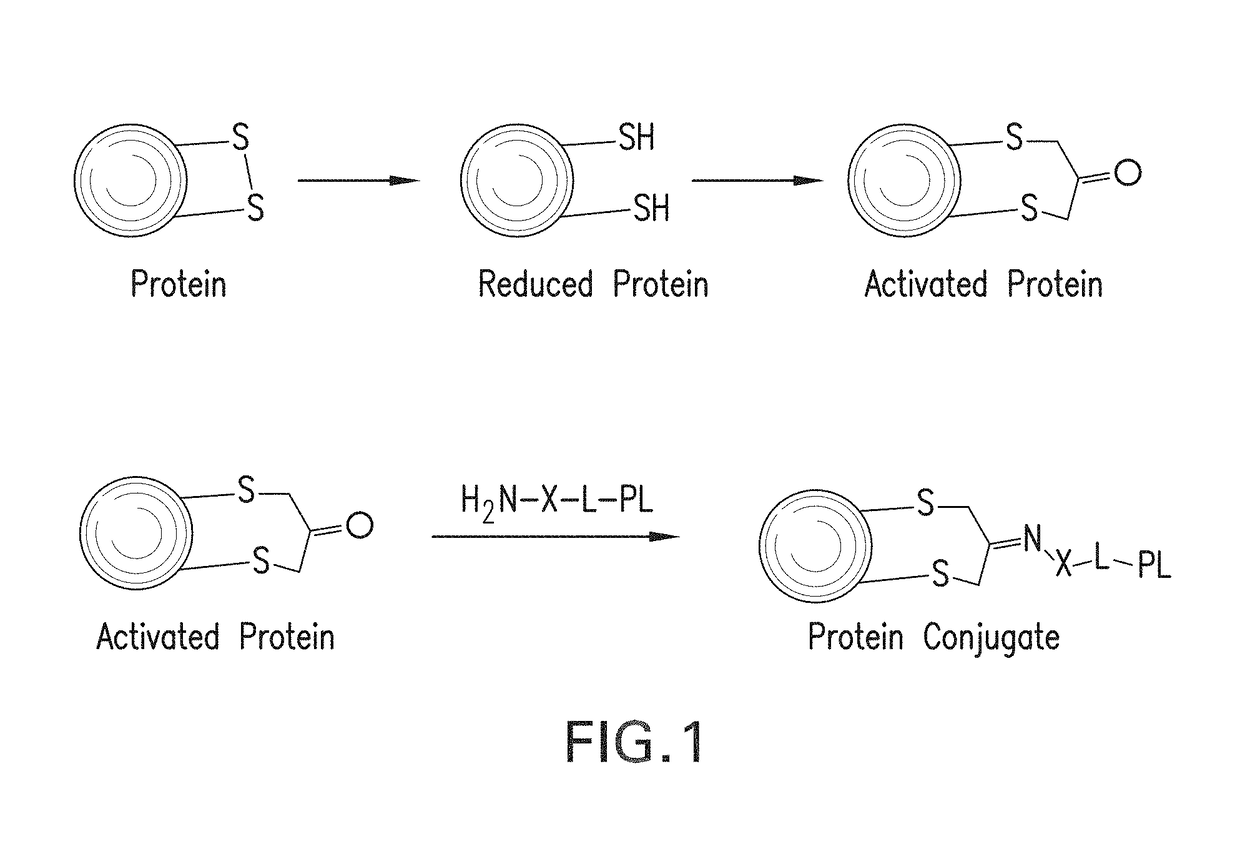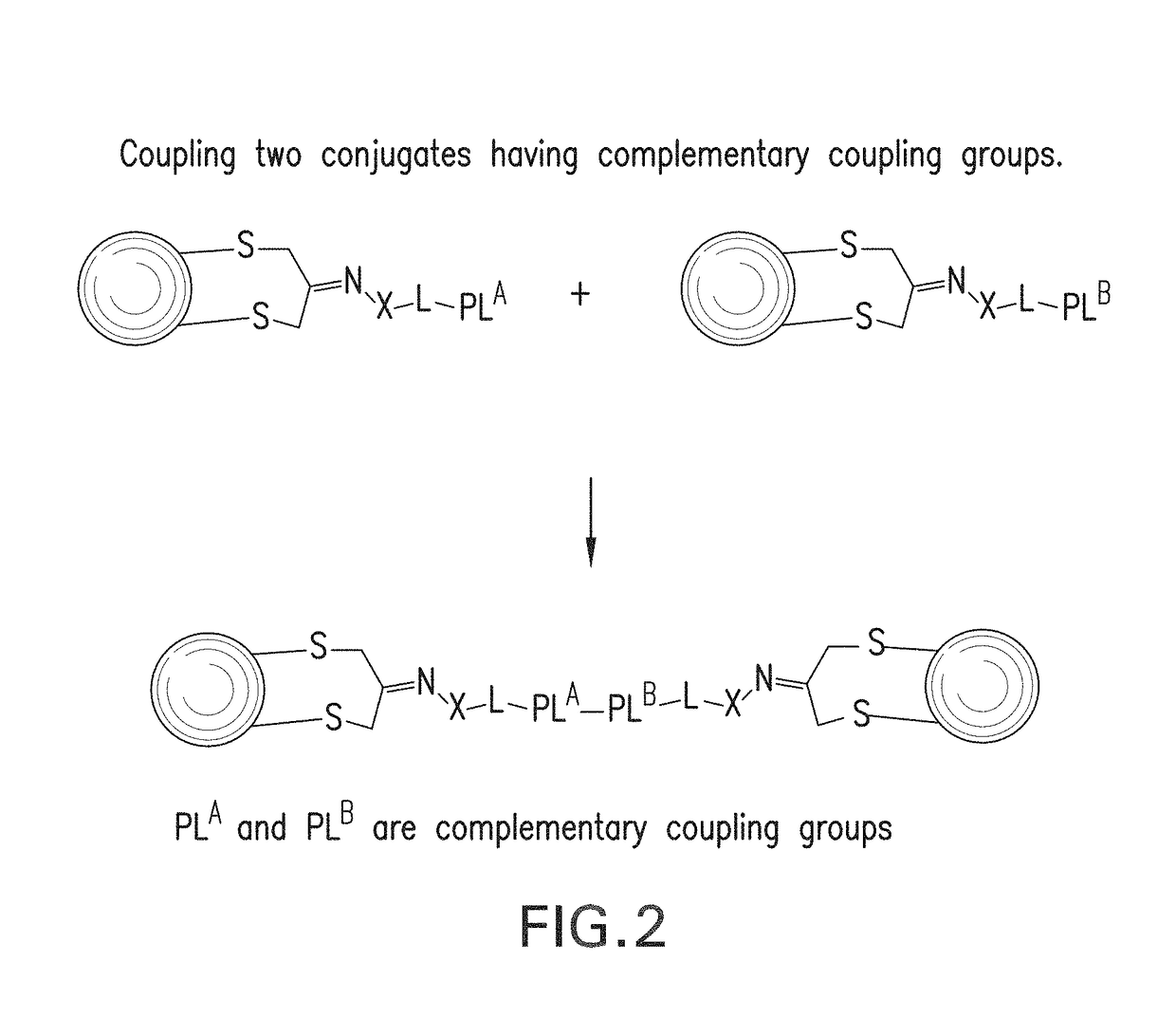Methods for making conjugates from disulfide-containing proteins
a disulfide-containing protein and conjugate technology, applied in dental surgery, tooth capping, snoring prevention, etc., can solve the problems of complex reliance on these naturally occurring reactive sites, significant affecting the activity or properties of the conjugate, and difficult to get the right ‘loading’ of payload on the protein, etc., to achieve greater stability and minimize any adverse effect on the conformation of the protein
- Summary
- Abstract
- Description
- Claims
- Application Information
AI Technical Summary
Benefits of technology
Problems solved by technology
Method used
Image
Examples
example 1
[0143]CRM197 (ref: G. Giannini and R. Rappuoli, Nucleic Acids Res., 1984, 25, 4063.) was treated with TCEP (xx), resulting in reduction of the C201-C185 disulfide, with little or no reduction of the C451-C471 disulfide (see Example 3). The reduced CRM197 was treated with 1,3-dichloroacetone to provide the activated protein, having the C451-C471 disulfide intact and with C201 tethered to C185 via a —CH2—C(═O)—CH2— linkage. This activated protein was contacted with PL1, the aminated fatty acid derivative containing an aminooxy group whose preparation is described above, to form an oxime linking the fatty acid derivative to the protein. The conjugate with the attached fatty acid group is expected to reduce renal clearance, thus extending the circulating half-life of the CRM197 protein and increasing its usefulness as a carrier in conjugate vaccines. Mass spectral data for the native protein (FIG. 3A, using Method A), the activated protein (FIG. 3B) and the protein conjugate (FIG. 3C) a...
example 2
[0156]Starting material preparation: Synthesis of pE-R—P—R-L-C—H—K-G-P-Nle-C—F—OH (disulfide C6-C12) (8)
[0157]
[0158]Preparation of Intermediate 8a
[0159](Loading of 2-Chlorotrityl Chloride Resin with Fmoc-F—OH, Fmoc Removal and Determination of the Loading of the Resin)
[0160]2-Chlorotrityl chloride resin (40.0 g, 64.0 mmol) was washed with DCM (3×). A solution of Fmoc-F—OH (24.8 g, 64.0 mmol) in DCM (400 mL) and DIPEA (44.7 mL, 256 mmol) was added and the suspension was shaken for 22 h at room temperature. The resin was washed thoroughly with DCM / MeOH / DIPEA (17:2:1) (3×), DCM (3×), DMA (3×), DCM (3×). The resin was then treated four times for 10 min with a mixture of piperidine / DMA (1:4) (400 mL) followed by washing with DMA (2×180 ml). The piperidine / DMA solutions and DMA washing solutions were collected for determination of the loading of the resin. 1 mL of the combined solutions was diluted to 500 mL with MeOH and the UV absorption at 299.8 nm was measured to be A=0.368. This corr...
example 3
[0177]
[0178]Into a solution of CRM197 (200 μg, 6.2 ul, 0.0034 μmol) in 50 mM Na phosphate buffer pH7.4 (10 μl) was added aqueous solution of TCEP HCl (5.89 μg, 0.021 μmol). This reaction mixture was left for 15 h at room temperature. 1,3-dichloropropan-2-one (4.58 μg, 0.034 μmol 10 eq) was added into the mixture. This reaction was left at room temperature for 2 h. The crude was passed through a Zeba™ size exclusion column. LCMS; [M+1]=58465. This activated protein can be reacted with an aminated payload such as a TLR agonist, to form a carrier protein conjugated with a compound that may enhance immune responses to any antigen added to the carrier protein.
[0179]
[0180]Into a solution of ketone-modified CRM197 (5 mg / ml, Na phosphate buffer, pH6.0) (50 μg, 0.00086 μmol) were added N-(3-(4-(2-(4-(2-(5-amino-8-methylbenzo[f][1,7]naphthyridin-2-yl)ethyl)-3-methylphenoxy)ethyl)piperazin-1-yl)propyl)-2-(aminooxy)acetamide (66.8 μg, 0.064 μmol) and aniline (0.0020 μl, 0.021 μmol). This reacti...
PUM
| Property | Measurement | Unit |
|---|---|---|
| molecular weight | aaaaa | aaaaa |
| molecular weight | aaaaa | aaaaa |
| temperature | aaaaa | aaaaa |
Abstract
Description
Claims
Application Information
 Login to View More
Login to View More - R&D
- Intellectual Property
- Life Sciences
- Materials
- Tech Scout
- Unparalleled Data Quality
- Higher Quality Content
- 60% Fewer Hallucinations
Browse by: Latest US Patents, China's latest patents, Technical Efficacy Thesaurus, Application Domain, Technology Topic, Popular Technical Reports.
© 2025 PatSnap. All rights reserved.Legal|Privacy policy|Modern Slavery Act Transparency Statement|Sitemap|About US| Contact US: help@patsnap.com



